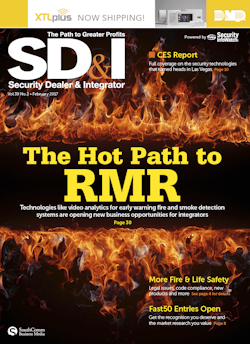While innovation is crucial, personal safety is absolutely critical. That is probably the best explanation as to why the fire industry has historically been seen as slower to adopt emerging technologies than other life safety sectors such as physical security, where consumer technology trends have greatly influenced offerings. That’s not to say, though, that advances are not being made or adopted – they are just made under intense scrutiny to ensure they comply with strict regulations and do their most important jobs: protecting human lives.
“Each advancement in fire alarm safety technology provides better fire alarm protection that is intended to save lives in a fire,” says Kevin Green, regional branch manager of low-voltage integrator Pyro-Comm Systems Inc., in the San Francisco bay area.
Green has seen this play out over several years, watching the industry go from fire bells to electronic horns, then to visual notification devices (strobes) as part of the Americans with Disabilities Act of 1990, and eventually to the requirement for synchronized fire strobes. Today, newer fire alarm codes requirements include 520 Hz low frequency sounders in bedrooms – and wireless fire alarm notification is on the horizon as well.
IP Opens the Door to Profits
Another area in which manufacturers are experimenting is IP-compatible fire verification solutions and extra-secure mesh networking; however, the real opportunity for manufacturers and installers may lie in the many code-compliant “add-on” solutions in this space that are enabling the fire industry to open new paths to recurring monthly revenue (RMR).
Video analytics is one of the more-promising add-ons as of late – particularly when it is combined with standard smoke and flame detection for an integrated early warning system. Historically, security and fire have been siloed, but in true IoT fashion, this new approach is taking steps to bridge that gap.
How it works: An analog or digital camera captures an image, which is then processed by proprietary software to determine if smoke from a fire is present. Specialized algorithms use advanced analytics techniques to identify the smoke characteristics and are primarily based on spectral, spatial and temporal properties, including changes in brightness, contrast, shape, edge content, motion and color matching. Upon verification, the system will show the smoke or flames by highlighting the contour(s) of the smoke cloud(s). That way, confirmed alarm scenarios are made very clear to the monitoring central station, as well as to key stakeholders via laptop or mobile devices.
The combined technologies have not yet reached the reliability and maturity to be approved as primary smoke/flame detectors, but they have developed significantly over the past 10 years, and are increasingly being adopted by customers. This can mainly be attributed to the growing appeal of IP-enabled technology among end-users, and advancements in the technology itself: improved CPU power of cameras, increasing image quality and decreasing prices. For customer sites that already have a fire/smoke detection system in place, these types of add-ons could be a strong way to grow an dealer/installer’s businesses.
The Value of Fire/Smoke Verification
One of the key advantages of installing these systems is the ability to visually verify an alarm condition in real-time – which is already an established concept in intrusion detection. The global fire/smoke verification market continues to suffer from an enormous amount of false alarms, which drains resources and trust from local fire emergency services. As more fire departments are looking to recoup costs, certain municipalities will now no longer respond to a threat unless it is visually verified.
Regardless of local fire department requirements, customers are generally willing to invest in the improved situational awareness the combined solution provides. The analytics software brings convenient mobile visibility from anywhere, and enables first responders to take the most informed and efficient action possible to save lives and minimize damage.
In fact, certain solutions include smartphone apps that enable first responders to see exactly what the central station sees. So, for example, a firefighter responding to an alarm could watch an emergency unfold from a phone while en route, and know exactly which areas to avoid upon arrival.
Beyond live access and threat verification, recorded video from past events can be very valuable for forensic and post-mortem analysis. Visual evidence helps to determine the origin of the fire and take steps to prevent a similar incident in the future.
Finding the RMR
There are many advantages of video verification for the end-user and for first responders, but as mentioned before, it also opens new markets and RMR opportunities for dealers.
Video verification is an especially beneficial add-on for dangerous or unmanned facilities, and large areas where it takes longer for smoke to rise to ceiling detectors. These facilities could include factory warehouses, nuclear power plants, shopping malls, locked or sterile environments such as laboratories, and remote utility substations.
The video analytics can also come in more specialized forms to detect, for example, diesel fumes, carbon monoxide and slow wire burn in data centers, beyond just smoke. Many of these spaces truly need the extra security net provided by video analytics because of their sizes and operational set-up.
Installing these types of solutions can also save time and operational costs because it can leverage existing infrastructure. For example, some manufacturers, such as Xtralis (acquired by Honeywell in 2016), can run the threat verification solution over already-installed, industry-standard security cameras connected to a special server/gateway. This enables the dealer to deploy the solution using regular PTZ cameras, and makes it perfect for retrofitting.
Many surveillance systems already have PTZ camera systems in place, so it is simply a matter of pushing out the right analytics software. In other words, no wiring or truck rolls are needed – which can be ideal because wired solutions can obviously be intrusive and expensive. This on its own can help broaden the market for installers.
“We can install wireless systems so much faster and economically than the traditional hardwired systems using conduit and wire,” says Scott Volkening of Fox Valley Fire & Safety, Chicago.
A true upside for dealers is being able to add RMR in the form of remote monitoring. Verification solutions are monitored by a central station so smoke/fire threat can continuously be verified professionally. This leads to a small monthly fee from the end-user, but combining those small costs with operational savings can create big benefits.
While Fox Valley Fire & Safety, Pyro-Comm Systems and many other fire integrators around the nation are big believers in emerging technologies, they know the true challenge that lies ahead is in educating the right people, such as authorities having jurisdiction (AHJs) about things like wireless fire systems and others.
At the same time, as Fox Valley Fire & Safety president Ken Volkening points out that fire alarm systems do not last forever. While emerging technology adoption does not exactly move fast in this industry, there are plenty of systems that are decades old and are not able to physically accommodate technology required by updated codes. “More property owners for numerous reasons are looking to voluntarily replace systems to get something better,” Ken Volkening says.
For dealer/installers, that means more opportunities to modernize with emerging solutions, like video content analytics.
David George is Marketing Communication Director for Honeywell Security and Fire (more info at www.securityinfowatch.com/10213896). Fred Koons is Corporate Communications Director at Xtralis, a Honeywell company (more info at www.securityinfowatch.com/10215673).



